우신정맥 합류부를 침범한 하대정맥 평활근육종의 수술적 접근법
The surgical approach for the inferior vena cava leiomyosarcoma including the confluence of right renal vein: A case report of patch venoplasty with right renal vein reimplantation after complete tumor resection
Article information
Trans Abstract
Surgical approaches for leiomyosarcoma of the inferior vena cava (IVC) are based on tumor location. Radical resection for the IVC leiomyosarcoma involving the renal vein has traditionally included nephrectomy with renal vein ligation or kidney autotransplantation. A 51-year-old woman was admitted for elective surgery for the tumor of IVC. At surgery, the tumor was located in front of IVC, abutted with right renal vein. After the tumor resection, IVC reconstruction involved the patch cavoplasty with cryopreserved cadaveric vein graft and the implantation of the right renal vein into the inferior IVC. The patient recovered fully without any postoperative complications including kidney function change. This technique could be adopted for tumors located in front of IVC involving renal veins, provided complete resection of the tumor with a comfortable resection margin is possible.
INTRODUCTION
Although tumors of the inferior vena cava (IVC) are rare, the IVC is the most common site of leiomyosarcomas of vascular origin. Complete surgical resection is particularly challenging due to the anatomical location of IVC leiomyosarcoma. In this study, we described a case of IVC leiomyosarcoma involving the renal veins. After complete tumor resection, we performed the IVC reconstruction using the patch cavoplasty technique with cryopreserved cadaveric vein graft and right renal vein reimplantation instead of kidney autotransplantation. To our knowledge, there are no published reports of this unique reconstruction method.
CASE REPORT
A 51-year-old woman without major medical history was admitted for surgical treatment of IVC mass. The mass was detected by computed tomography (CT), during a routine check-up. The patient did not show any symptoms. Subsequent to CT, we used magnetic resonance cholangiopancreatography (Fig. 1). The mass began from the inferior hepatic IVC and extended below the right renal vein. The mass showed concave border with anterior side of IVC, rather than compressed IVC; hence, the diagnosis was leiomyosarcoma originated from the wall of IVC.

Magnetic resonance imaging shows the inferior vena cava mass (*). (A, B) Enhanced T1 weighted axial image (portal phase), (C) Enhanced T1 weighted axial image (arterial phase), and (D) T2 weighted coronal image. All images were fat-saturated.
The patient underwent surgery in January 2016. After a long midline incision, the IVC was exposed by Kocher maneuver and right colon mobilization. There was no infiltration into the gallbladder, the main portal vein, the duodenum and the head portion of pancreas. The tumor involved infrahepatic IVC and extended distal to the renal vein. The right renal vein was abutted with the tumor, but the left renal vein was displaced and not abutted. There was no invasion of the right renal artery, because the tumor was located at the anterior side of IVC (Fig. 1C). We planned to perform the right renal vein reimplantation into the inferior IVC without right kidney autotransplantation. The upper and lower portion of IVC were identified by vessel loops, as well as the right and left renal vein (Fig. 2A). Before resection of the IVC mass, the right renal vein was reimplanted 2 cm distal to the IVC (Fig. 2B). After ligation of the right renal vein in situ, the total reanastomosis time of right renal vein was 8 minutes. We applied vascular clamps in order of inferior IVC, superior IVC, and left renal vein. We resected the tumor, including the anterior wall of IVC for safe resection margin, and subsequently performed a patch-cavoplasty using cryopreserved allograft (cadaveric iliac vein). After the cavoplasty, we declamped in reverse order of clamping. The IVC and the left renal vein were clamped for 23 minutes, and the total estimated blood loss was 600 mL. Caval shunt was not used during the IVC reconstruction.

Surgical photos. (A) Inferior vena cava with tumor and right renal vein (black arrow) in situ. The upper and lower portion of IVC are indentified by two red vessel loops, and the right and left renal vein by two blue vessel loops. (B) Reconstruction of the IVC (patch-plasty with cadaveric iliac vein) and reimplantation of right renal vein (black arrow). (C, D) the IVC tumor demonstrates a grossly negative resection margin. IVC, inferior vena cava.
The pathologic diagnosis of the tumor was consistent with a 7.5 cm sized leiomyosarcoma (Fig. 2C, D). The mitotic rate was up to 16/10 high power fields (HPFs), and the tumor necrosis was present within 50%; so, French Federation of Cancer Centers Sarcoma Group grade was 2.
The patient had a routine clinical course without any complications except for a 1 cm sized bland thrombus at the reimplantation site of right renal vein in the postoperative CT (Fig. 3A, C). The patient was discharged on the 13th day post-surgery with a prescription of prophylactic low-dose aspirin.

Axial (A) and coronal (C) image of postoperative 7 days follow-up computed tomography (CT) and axial (B) and coronal (D) image postoperative 3 months follow-up CT. Image A and C shows bland thrombosis (white (A) and black (C) arrow) at reimplantation site of right renal vein. In follow-up CT 3 month after surgery, the thrombosis was resolved (B, D).
DISCUSSION
IVC is most common site of leiomyosarcoma originated from vascular smooth muscle. According to anatomical level, the IVC is classified as three segments. Segment I starts from the illiac vein to the infrarenal portion of the IVC; Segment II from the renal vein to the retrohepatic portion of the IVC; and Segment III from the hepatic veins to the right atrium [1]. For radical resection of the IVC leiomyosarcoma segment II, the problem of renal vein reconstruction has to be overcome. The ligation of left renal vein is usually tolerable due to the collateral venous drainage of the left kidney such as adrenal, inferior phrenic, azygous, gonadal, and paravertebral vein [2]. On the contrary, the blood flow of the right renal vein should be restored because of the lack of collateral pathway [3]. Furthermore, this problem can extend to whether the adjacent kidney should be preserved or sacrificed. Several case reports have described IVC reconstruction with preservation of the adjacent kidney using various surgical approaches to resect IVC tumor involving renal vein (Table 1) [3–13].

Chronological case reports describing surgical management including radical resection of IVC leiomyosarcoma involving renal vein confluence
To our knowledge, this is the first case of simultaneous allograft patch cavoplasty and right renal vein reimplantation for reconstruction of the IVC and renal vein. In our case, the tumor was located in the anterior wall of IVC of segment II. We were able to perform a patch-cavoplasty for the IVC reconstruction instead of the cava replacement, due to the tumor location [14]. The left renal vein was displaced and it was possible to retain the surgical margin. Even though the confluence of right renal vein was closed to the tumor, right kidney autotransplantation was not required, because the right renal artery passed the posterior wall of IVC. Thus, it was sufficient to perform right renal vein reimplantation into the inferior IVC.
As shown in Table 1, two cases used the method of renal vein reimplantation. The left renal vein was reinserted into the superior IVC in one case; and another case used the right renal vein transposition into the PTFE graft [7].
In the case of kidney autotransplantation or caval replacement followed by renal vein reimplantaion into the graft, the clamping time of renal vein can be longer than our case.
During the immediate postoperative course, our patient showed normal kidney function (Fig. 4). The 3 months follow up CT indicated that the patient was recurrence free and the bland thrombosis at the reanastomosis site of right renal vein was resolved (Fig. 3).

The change of Cr and eGFR level of patient (normal range: Cr, 0.6–1.1 mg/dL; eGFR, 60–150 mL/min/1.73 m2). Cr, creatinine; eGFR, estimated glomerular filtration rate; Preop, preoperative; OP, operation; POD, postoperative day.
In conclusion, for radical resection of the relatively small sized leiomyosacoma located in anterior wall of the IVC, right renal vein reimplantaton followed by a patch-cavoplasty might be applied if the length of the right renal vein is sufficient after the resection.
CONFLICT OF INTEREST
No potential conflict of interest relevant to this article was reported.